Which sort of pear is better: "Lada" or "Chizhovskaya"
Lada pears have a thin and smooth light yellow skin with a faint scarlet blush, and the juicy pulp is yellowish-white fine-grained. The fruits of the Chizhovskaya variety are distinguished by a uniform yellow-green color with a blurred pale pink blush. Their flesh is light yellow or white, semi-oily in texture. Consider which pear is better - Chizhovskaya or Lada. Let's talk about their features, advantages and disadvantages, the nuances of landing and care.
The content of the article
Pear Lada: variety description
The early ripe pear variety Lada was bred at the Moscow Agricultural Academy. K. A. Timiryazeva by crossing the cultures Forest Beauty and Olga. The authorship belongs to the Russian breeders S. T. Chizhov and S. P. Potapov. The variety was included in the State Register in 1993.
Reference! The most favorable conditions for growing Lada pears are southern Russia and regions of the middle lane.
The culture is suitable for growing in the Central, Central Black Earth, Middle Volga, North-West and East Siberian regions. The variety is widespread in the Moscow region.
Description of the tree
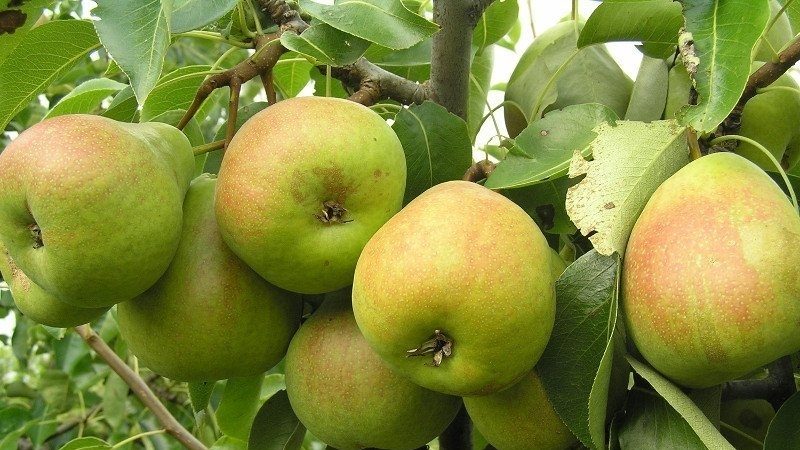
Standard trees, medium size... Height - 2.5–3 m. The crown is medium-leafy and dense. Its shape changes as the tree develops: at a young age it is pyramidal, during fruiting it is cone-shaped. The lifespan of a tree, according to the resident, is 50–90 years.
The bark on the skeletal branches is gray, on the trunk it is darker. Rings are final, sedentary. The type of fruiting is mixed. Shoots are long, of medium thickness, curved, rounded brown in cross section.
Lint-free internodes, short. Lentils are small, located at surface level, there are few of them on the shoots. The kidneys are dark brown, conical, deviated. Leaves are medium-sized, green, oblong-oval. The plate is shiny, elastic and smooth, of moderate thickness, slightly curved along the central vein, without pubescence. The edges of the leaves are serrated. Petioles are of medium length.
The flowers are cupped, medium in size. Corolla is white, petals are entire, medium-closed. White buds. Inflorescences are racemose, each with 5 to 7 flowers.
Description of fruits
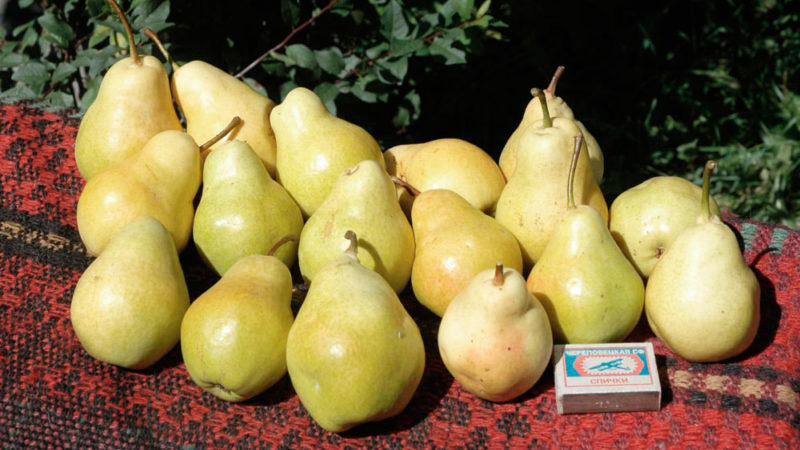
Fruits are medium in size, obovate, weighing 100-120 g. The skin is thin, smooth. The color is light yellow, with a faint scarlet blush. There are few subcutaneous points, they are poorly visible on the surface. In the area of the stalks there is a slight rustiness.
The peduncles are short, of medium thickness. There is no funnel. The saucer is small, narrow and lumpy. The cup is open. The sub-cup tube is medium. The axial cavity is medium in size. The heart is oval, weakly expressed. Seeds are medium in size, brown in color, 5-6 seeds in each fruit.
The pulp is yellowish-white, medium-dense, fine-grained. The taste is sweet and sour, the aroma is weak. Tasting score - 4-4.4 points on a 5-point scale. The content of dry substances per 100 g is 15.7%, soluble substances - 12.2%, sugars - 7.2%, acids - 0.27%.
The purpose of the variety is universal... The fruits are suitable for fresh consumption, making jam, preserves, compotes and dried fruits. Low shelf life: only 2 months if the room temperature is kept below 0 ° C. Fruit shedding is weak. Transportability is low, marketability is high.
Frost and drought resistance
Lada's winter hardiness is high, trees do not need shelter for the winter. Heat resistance is moderate - plants are watered abundantly during prolonged drought.
Disease and pest resistance
The variety is resistant to adverse environmental factors, rot, fire blight and scab. Trees are susceptible to attacks by aphids, hawthorn, and pear honeydew.
Pollinators
Pear Lada partially self-fertile therefore, it needs additional pollination. The best pollinators for the variety - Chizhovskaya, Kosmicheskaya, Skorospelka, Rogneda, Moskvichka, Severyanka, Otradnenskaya, Memory of Zhegalov.
Flowering and ripening period
Pear Lada enters the flowering period in April-May. Fruiting begins 3-4 years after planting and peaks in 6-7 years. The fruits ripen regularly, from year to year. Harvested in July-August.
Yield
The yield of the Lada pear is high. With proper care, 45-50 kg (or 10-15 buckets of fruit) can be harvested from one tree. Fruits are evenly distributed on the tree, at the top ripen the largest specimens weighing up to 200 g.
Advantages and disadvantages
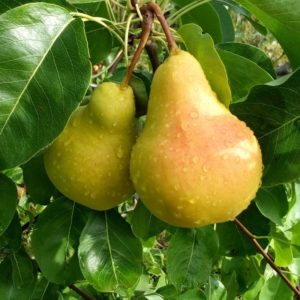
Variety advantages:
- early maturity;
- high winter hardiness and productivity;
- resistance to scab and other diseases;
- excellent fruit taste.
Disadvantages:
- short storage period;
- low level of transportation.
Description and characteristics of the pear variety Chizhovskaya
The mid-season Chizhovskaya was bred at the Moscow Agricultural Academy. K. A. Timiryazeva by crossing the varieties Lesnaya Krasavitsa and Olga. The authorship belongs to the breeders S. T. Chizhov and S. P. Potapov. Culture was included in the State Register in 1993.
The variety is intended for cultivation in the Central, Volgo-Vyatka, Middle Volga and North-West regions. Chizhovskaya received the greatest distribution in the Vladimir, Moscow and Samara regions.
Description of the tree
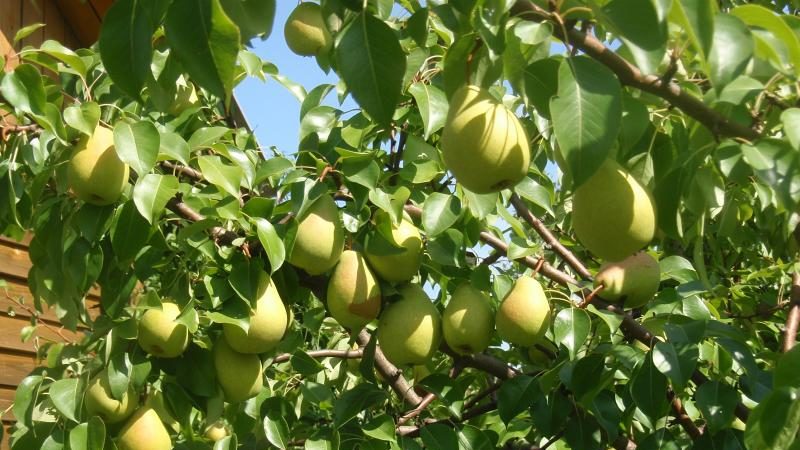
Trees with an average height of 1.8–2.5 m of a standard type with a dense, medium leafy crown. Its shape at a young age is elongated and narrow, in the fruiting one it is cone-shaped or pyramidal. The bark on the trunk is dark gray. Skeletal branches are located vertically, at a slight slope, painted gray. The type of fruiting is ringed. The lifespan of a tree, according to the resident, is 50–90 years.
Shoots of medium thickness and length, slightly curved, with a rounded cross section, colored reddish or dark brown. Lint free internodes, medium length. Lentils are small, few, located at the surface level. The buds are dark brown, slightly deviated, conical.
Leaves are medium in size, elongated, elongated-oval, green in color. Curvature is observed along the central vein. The edges of the leaf plate are serrate-serrated. Leaves of medium thickness with a smooth surface without edge. Petioles are of moderate length; stipules are lanceolate.
The flowers are medium in size, cupped. Corolla is white, petals are solid, medium-closed. White buds. The type of inflorescences is corymbose, each with 5–7 flowers.
Description of fruits
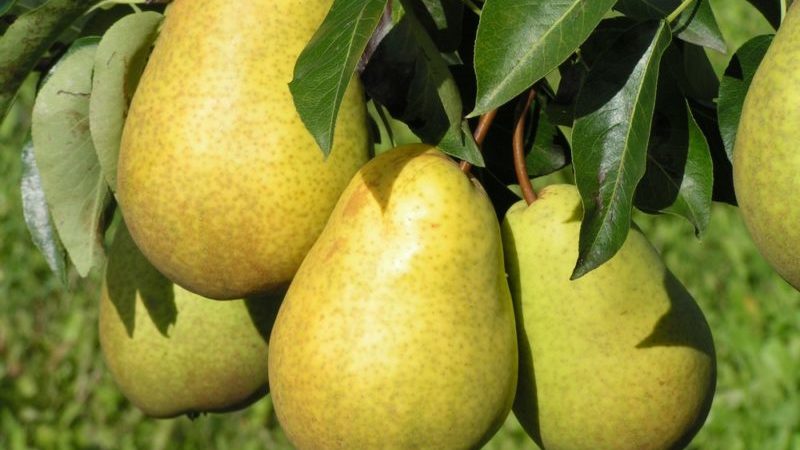
Fruits are medium in size, weighing 110-140 g. The form is obovate. The skin is smooth, thin, matte. The color is yellow-green, with or without a blurred pale pink blush. The subcutaneous points are small and weakly expressed. Rustiness is insignificant. The peduncles are short, of medium thickness. The funnel is narrow, small and ribbed. The saucer is small, narrow, lumpy. The calyx is open, the sub-mucosa is of medium size. The axial cavity is medium. The heart is broadly oval, without granulations.
Seeds are medium in size, brown in color. Each fruit contains 5-10 pieces. The pulp is light yellow or white, melting semi-oily.Average juiciness, delicate aroma.
The taste of the pulp is sweet and sour, refreshing. Tasting score - 4.1-4.2 points on a 5-point scale. The content of dry substances in 100 g is 16.5%, soluble substances - 13.1%, sugars - 9.1%, acids - 0.45%.
The purpose of the fruit is universal. They are used to prepare compotes, preserves, jams, marmalade and dried fruits.
Frost and drought resistance
Chizhovskaya pear is resistant to frost, therefore, it does not need shelter for the winter. The drought resistance of the variety is high, but during a prolonged drought, it is important to water the trees abundantly.
Disease and pest resistance
The variety is distinguished by increased resistance to scab and rot, unfavorable weather factors. Trees are susceptible to attacks by aphids, hawthorn, and pear honeydew.
Pollinators
The Chizhovskaya pear variety is self-fertile, but to increase yields, it is recommended to plant pollinating trees 3-4 m apart. Severyanka, Rogneda and Lada are suitable for this.
Flowering and ripening period
The flowering period begins in April-May. The pear is early-growing, the first fruits are removed in August in green form and left to ripen in partial shade. In the period of regular fruiting, the plant enters 3-4 years after planting.
Yield
The productivity of Chizhovskaya pear is high. With proper care, 50-60 kg (or 11-16 buckets of fruit) are harvested from one tree.
Advantages and disadvantages
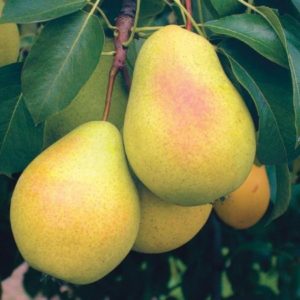
Pros of the variety:
- early maturity;
- self-fertility;
- high frost resistance;
- presentation and excellent taste of the fruit;
- disease resistance.
The main disadvantage of the plant is that as it grows, the fruits become smaller.
Reference. Given the tendency to branchiness and shrinkage of fruits, it is recommended to carry out anti-aging pruning in early spring.
Comparison of two varieties
Pears Lada and Chizhovskaya were bred on the basis of the Lesnaya Krasavitsa and Olga varieties, so they have similar characteristics. It is impossible to say unequivocally which one is better or worse. Gardeners appreciate both plants for their high yield and excellent fruit taste.
The table clearly shows the parameters of two varieties that will help gardeners choose the most suitable one:
| Parameters | Lada | Chizhovskaya |
| Growing regions | North-West, Central, Central Black Earth, Middle Volga, East Siberian | Central, Srednevolzhsky, Volgo-Vyatsky, North-West |
| Tree height | 2.5-3 m | 1.8-2.5 m |
| Fruit weight | 100-120 g | 110-140 g |
| Skin | Thin smooth light yellow, with a faint scarlet blush | Smooth, fine dry, yellow-green color, with or without a washed out pale pink blush |
| Taste | Sweet and sour | Sweet and sour |
| Scent | Weak | Delicate, thin |
| Pulp | Yellowish-white medium-dense fine-grained, juicy to taste | Light yellow or white, semi-oily melting |
| Yield | 45-50 kg | 50-60 kg |
| Keeping quality | Low (2 months) | Medium (2-4 months) |
| Transportability | Low | High |
| Frost resistance | High | High |
| Immunity | To scab, rot, fire blight | To scab, rot |
Planting and growing pears Lada and Chizhovskaya
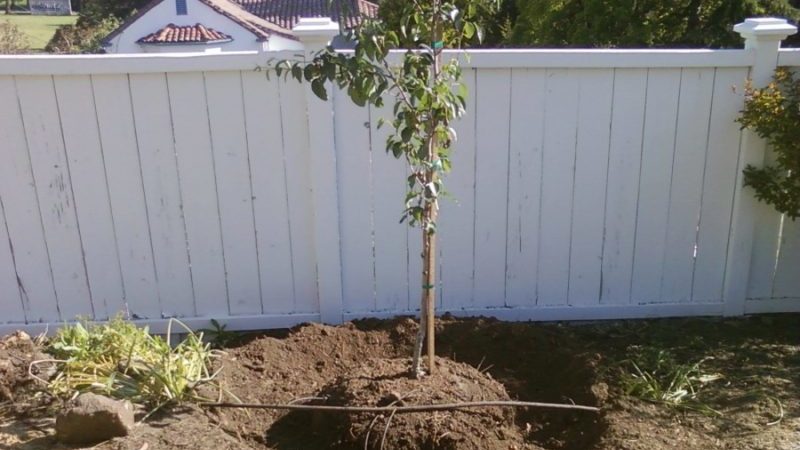
Both pears are unpretentious in care, and even novice gardeners have no problems with planting them. Plants are recommended to be planted in spring. In some cases, this is done in the fall, a month before the first frost.
For Chizhovskaya and Lada pears, chernozem or loam with a slightly acidic reaction is suitable. The soil is pre-fertilized with humus, lime, superphosphate and potassium chloride.
Reference! Clay soil is not suitable for plants due to its high density: this will impair the aeration of the root system, access to water and nutrients. Planting in sandy soil is allowed with the preliminary application of fertilizers: compost, peat and humus (10 liters per 1 m²).
The depth of the planting pit should not exceed 70 cm. The hole diameter is up to 110 cm. The grooves are prepared 6-7 days before planting. Walnut shells or crushed stone are placed on the bottom.
With a close occurrence of groundwater, ditches are dug at the site to drain them.The ideal place for planting pears is a small hill. This will protect trees from excess moisture, improve illumination and growth.
Saplings 1-2 years old are suitable for planting. They should be free of damage and signs of fungal infection. Healthy roots have a light cream shade in section.
To form an even crown, a wooden stake 50-60 cm high is driven in next to the seedling. The root collar is not buried, it should rise 6-7 cm above the surface. Root shoots are gently straightened and covered with soil. The planting hole is completely covered with earth, compacted and watered. Mulch with humus, peat, manure or straw. The trunk is tied to a dug-in peg.
Care
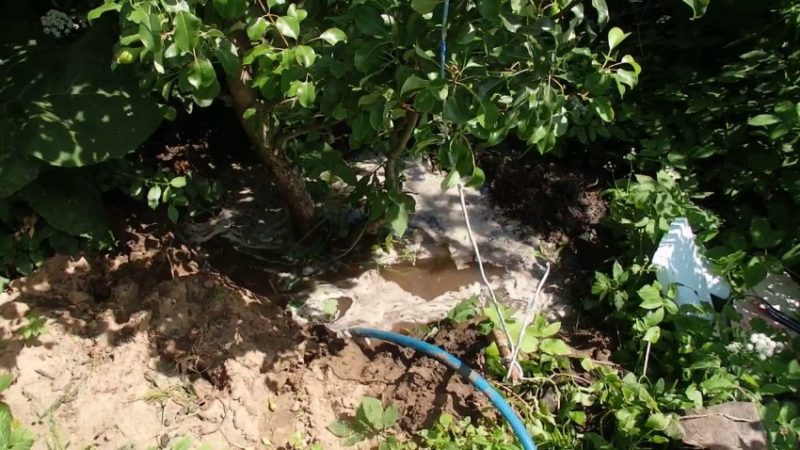
Basic rules of care:
- Trees are watered only during a prolonged drought. Frequent watering provokes decay of the root system and the addition of infections. Water consumption per tree is 10–20 liters.
- As feeding in early spring, nitrogen fertilizers are applied (10–20 g of urea per 10 l / 1 m²). The procedure is carried out after the snow has melted, but subject to dry weather. Damaged and dry branches are removed, and the trunk is treated with red lead or lime. In summer, the trunk circle is watered with a superphosphate solution (20-30 g per 10 l / 1 m²). In October, pears are fed with potassium sulfate (20–30 g per 10 l / 1 m²).
- In the first year, the ovaries perform thinning pruning to form the correct crown. The procedure is carried out in spring and autumn. With a sharpened and disinfected pruner, excess branches are completely cut off, long ones are shortened. Places of cuts are covered with garden pitch.
- The fight against insects begins before the start of sap flow. For this, a urea solution is used (700 g per 10 l of water). They process the trunks and the soil around. The tool effectively destroys pests that have wintered on trees and in the ground. It is important to ensure that the solution does not get on the kidneys, otherwise they will receive a severe burn. Preventive treatment is performed three times per season, regardless of the presence of pests.
- Against brown spot, use a 3% solution of Bordeaux liquid, drugs "Meteor", "Champion". Powdery mildew is fought with a solution of colloidal sulfur (25 g per 10 liters of water). Urea solution is effective against rust (700 g per 10 l).
Harvesting and storage
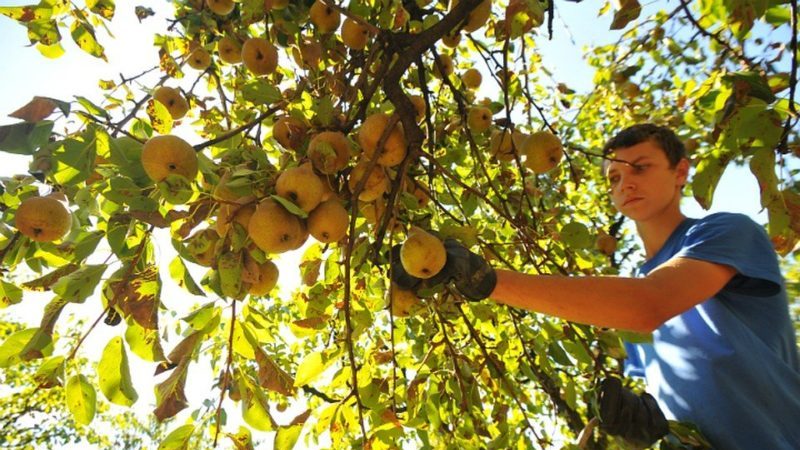
Both varieties are characterized by stable fruiting. Lada pears hang on the tree for a long time and do not crumble. When harvesting, it is not recommended to shake the tree, since the delicate skin of the fruit cracks from the blows, and the places of damage begin to rot.
The crumbling rate of Chizhovskaya fruits is low. When falling into the grass, ripe pears do not crack, do not lose their presentation within a week. Ripe fruits fall off in a heap, 4-5 pieces each, as they grow on the branches. This makes harvesting much easier.
Reference! It is recommended to transfer the harvested fruits with dry sawdust or paper for better preservation.
Chizhovskoy pears are stored for 2–4 months at a room temperature not higher than 0 ° C, Lada - 2 months under the same conditions.
Conclusion
It is difficult to compare Chizhovskaya and Lada pears - after all, they have common “parents”. They were bred on the basis of the varieties Lesnaya Krasavitsa and Olga. Lada is partly self-fertile and needs additional pollination. Chizhovskaya is completely self-fertile, and pollinating trees are planted nearby to increase yields. Sweet and sour taste and juicy fruit pulp in both varieties. Plants differ in the storage period of the crop: for Lada no longer than 2 months, for Chizhovskaya - 2-4 months in a cool place.